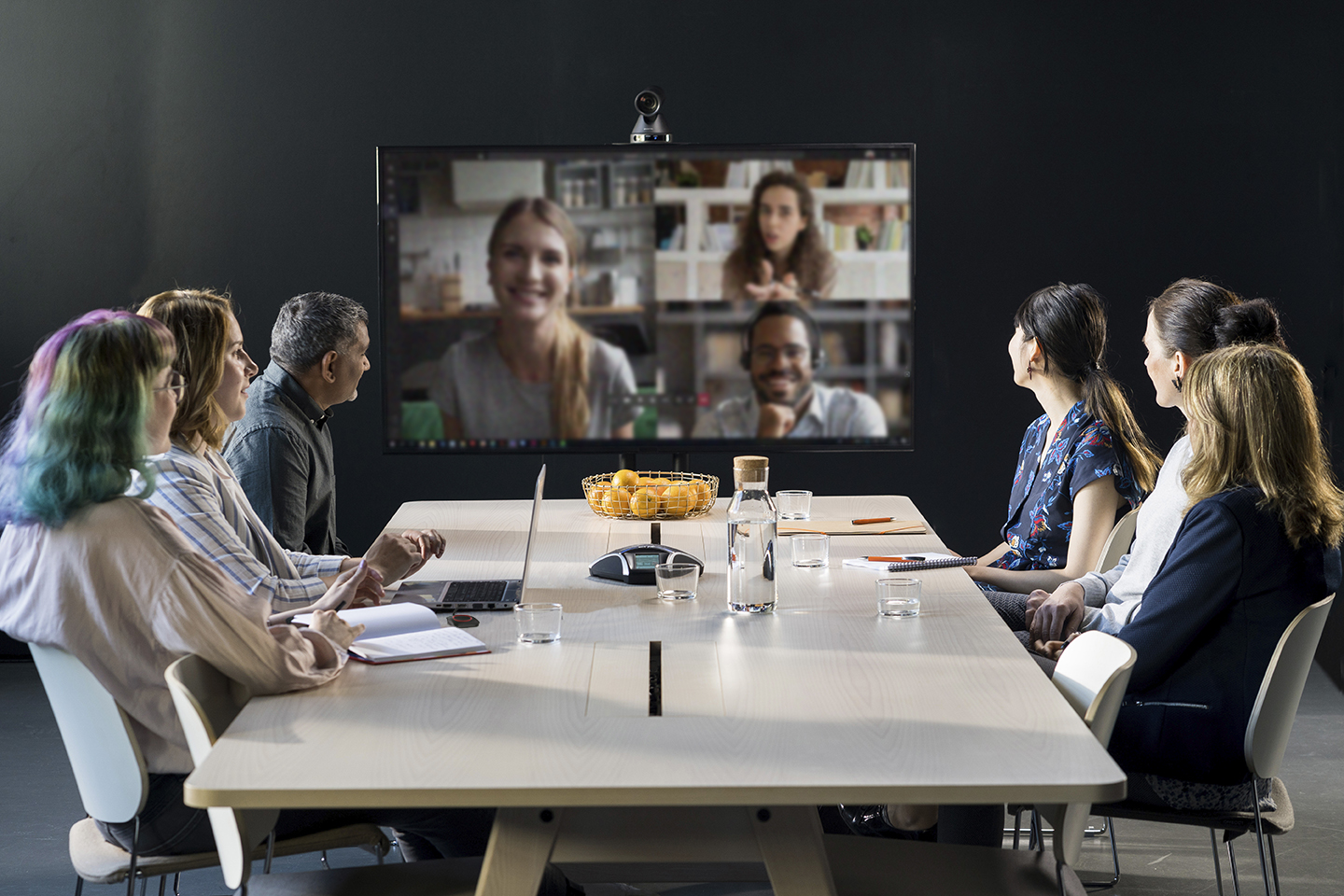2020 was a year of global societal change, and one of the most impactful cultural shifts in North America has been the rapid transition to a distributed workplace, with nearly all traditional office-based companies instituting work-from-home policies on a part-time or full-time basis.
[The Integration Guide to Conferencing & Collaboration]
As health guidance varied day-to-day and people began changing personal habits, every business from the largest multinational corporation to the smallest local office was faced with the reality that in-person meetings, daily office attendance, and business travel may truly never be the same.
For custom technology integrators, this society-wide movement has created abundant opportunities to introduce clients to new digital tools—particularly video collaboration technologies—and upgrade them for effective communication between traditional offices and countless new home offices.
By the Numbers
As traditional offices and work models get upended, hybrid work will lead to dispersed teams and a sustainable demand for more video meetings.
AV professionals can attest to a surging nationwide interest in video collaboration investments, and multiple research firms have found that the future looks very promising for technology integrators.
In February 2021, a Frost & Sullivan survey indicated that more than two out of three companies expect more than 25 percent of their employees to be fully remote throughout 2021, and that two out of five companies see more than 50 percent of employees working from home for the next year. Post-pandemic, the number of remote workers will be six to seven times greater, compared to the pre-pandemic situation.
[The Technology Manager's Guide to Collaboration in the Post-COVID World]
Based on these projections and business model adaptations, hybrid and flexible work will become the norm over the long term, with anywhere from 25 to 50 percent of knowledge workers being remote at least one day per week.
Taking a different tact, in August 2020 the Global Business Travel Association asked respondents their thoughts on the return of business travel, and nearly 40 percent agreed that they don’t expect pre-pandemic business travel practices until at least 2023, if ever. In fact, with the added concerns of corporate social responsibility and sustainability, not to mention cost and time savings, it’s possible and perhaps even likely that video collaboration will permanently supplant many meetings that previously required travel.
Businesses Must Adapt to Survive
Office-based companies striving for long-term success must be willing to adapt their business and employee models to accommodate a much wider variety of needs moving forward. In-office changes such as installing easy-to-use video collaboration tools, using alternating schedules, and reorganizing meeting rooms for social distancing will be crucial to encouraging some semblance of traditional office culture and productivity.
At the same time, many companies may make hybrid or work-from-home models permanent, opening a large new market of potential clients who need to work, collaborate, and present from home with the same level of technological sophistication and simplicity they enjoy in a corporate meeting room.
Manufacturers that design and build video conferencing, audio capture, and other relevant office technologies have been hard at work over the past year to launch new solutions specifically targeted to these new environments, providing integrators with every tool they need to optimize clients’ office and home office setups for efficient and reliable operation.
Leveraging no-touch solutions is an increasingly popular investment, such as mobile apps that can replace keypads to schedule meetings or control audio and video devices. With more and more companies adopting BYOD (bring your own device) practices in the office and at home, integrators must ensure that any new technology solution is device agnostic and is simple to operate regardless of which device, operating system, or software application is being used.
Steps for Hybrid Office Success
With these major shifts in mind, it’s critical for integrators to help companies maximize the effectiveness of these new work models. Here are a few tips that integrators can follow when pursuing this new opportunity:
Include everyone in the ‘hybrid’ team when designing video collaboration solutions. This involves making sure that employees can easily contact each other regardless of location, redesigning meeting rooms for any necessary in-person meetings, and being prepared and flexible with office design or work scheduling in case of unforeseen changes. Integrators can help clients prepare with cameras, microphones, speakers, and room reservation systems.
Make sure video conferencing is easy for your clients. By creating clear policies for minimum equipment requirements and use of software services, organizations can avoid anxieties about call quality and professionalism when meeting with outside partners. Using a single hardware supplier is an effective way to increase reliability and quality between multiple physical locations.
[Audiovisual Tools and Strategies for the Evolving Corporate Campus]
Upgrade the video quality. Cameras now exist for every need, from affordable 1080p stationary models with ultrawide lenses for small rooms to advanced 4K PTZ cameras with remote controls, noise cancellation, and subject tracking that can fully capture larger rooms. Some situations may call for multiple camera angles, such as one camera facing the seated participants and another facing a digital white board.
Also make audio quality a major focus. In-person meetings that are more physically spread out may require multiple microphones or speakerphones to adequately capture speech from a larger area. Home-based workers may opt to use headsets, but for long meetings or people who spend all day on video calls, a speakerphone solution may be the most effective and comfortable option.
The Longview on Hybrid and Remote Work
It’s increasingly likely that the future of office work will consist of hybrid and remote work models that encourage workers to work where they are most comfortable and use physical meeting spaces when they are convenient and efficient. Reduced desire for expensive high-frequency business travel will further increase the need for top-notch video collaboration technologies and infrastructure. With all these factors combined, custom integration professionals are perfectly positioned to deliver desperately needed solutions both in office buildings and in residences.
Stefan Eriksson is CMO at Konftel, a Sweden-based collaboration devices company. Prior to joining Konftel in 2014, he served as a journalist and editor for a number of news outlets, including a Swedish telecoms magazine. Eriksson is passionate about the user-experience, life-changing technology, and various outdoor activities.

